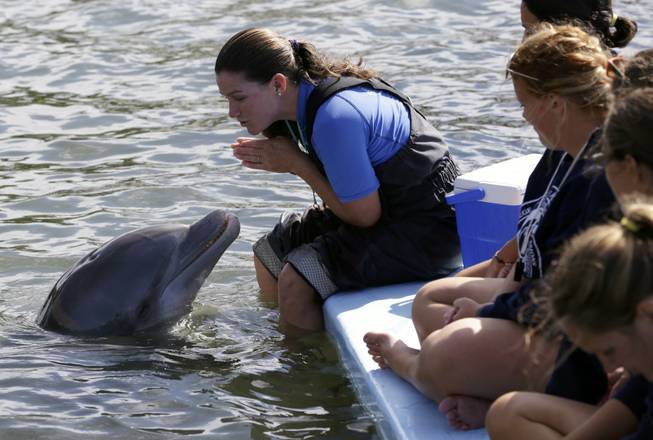
Lynne Sladky / AP Photo
Senior trainer Kelly Jayne Rodriguez, left, works with a dolphin named Molly, who is in her early 50s, as students look on at the Dolphin Research Center in the Florida Keys, Fla. Geriatric marine mammal care is becoming more important today as Molly and other dolphins in human care are living longer than their counterparts in the wild. To meet these growing needs, the center has established the College of Marine Mammal Professionals.
Wednesday, Dec. 18, 2013 | 6:31 p.m.
GRASSY KEY, Fla. — Molly, a bottlenose dolphin in her early 50s, can't see very well and requires special care. The staff at the Dolphin Research Center in the Florida Keys is teaching her to respond to verbal and touch-related signals before she loses her sight completely.
Molly isn't the only one learning from these sessions, which also include the first five students in the center's College of Marine Mammal Professions. The 36-week program that yields an Associate of Science Degree in Marine Mammal Behavior, Care and Training is the only one in the U.S. that teaches hands-on training and care of marine mammals, according to the International Marine Animal Trainers' Association.
The care of marine mammals is a growing but competitive field. In particular, geriatric marine mammal care is a field that is becoming more important these days as Molly and other animals in human care are living longer than their counterparts in the wild, said Kirsten Donald, the center's education director.
"We provide the same kind of care as with aging humans," Donald said.
The center's degree is an expansion on its week-long dolphin lab program that started in 1985. The college's first students, all women, will graduate in May and the college is looking to expand by offering other degrees in marine mammal professions. The program costs $20,310, including tuition and fees.
Most marine animal caregivers learn through internships, acquiring such skills as how to prepare an animal's meal. The research center's program teaches advanced skills such as how to calculate a diet based on the animal's age, health status or the season. Students learn how to create a diet for a nursing or pregnant mammal, Donald said.
The center has two nursing baby dolphins.
"You already have an edge in the fact that we went through and got to see a baby dolphin being born right in front of you," Donald told her students in a small classroom at the facility. "Talk about great education right there."
There are about 40 aquariums or theme parks in the U.S. that are potential employers of students who learn how to work with marine mammals, according to the Alliance of Marine Mammal Parks and Aquariums. The organization also has 26 international member institutions in Mexico, the Bahamas, Bermuda, Hong Kong, Europe and elsewhere.
The jobs are highly coveted, explained Ken Ramirez, the former president of the International Marine Animal Trainers' Association.
"For any position you have 100 applications. You have to do everything you can to get your resume to stand out and part of that is practical, hands-on experience as well as the education. And that's something unique that the program can offer," he said of the coursework at the center in the Florida Keys.
Samantha Sorbello, a recent graduate, said getting the hands-on education was difficult for her while in school because there were not a lot of places to get an internship while studying.
"When I saw this, I thought 'Oh my gosh, this is perfect.' I can get the hands-on experience. I'm going to be learning a whole lot and I don't have to worry about trying to fit it in with different things at the same time," said Sorbello, who's from Rhodes Island.
The center also teaches the students how to care for animals with special medical needs, such as Molly and Karen, a 27-year-old California sea lion who is blind. Karen has to use her sensitive whiskers to feel her way around her habitat.
On a recent day, trainer Kelly Jayne Rodriguez called out instructions as the sea lion swam closer to the dock.
"So you guys can see as I call her, she listens to my voice. Dock," she said as Karen shuffled her way onto the wooden dock. "She uses the whiskers to find the dock."
As Karen made her way to the center of the outdoor classroom, Karen said: "I'm still talking to her so she knows where I'm at. She follows my voice."
At this session, the students were learning how to give Karen eye drops.
"Eyes," Rodriguez says loudly as Karen's whiskers pluck up. The word "eyes" tells Karen to have her eyes open so Rodriguez can pour the drops in.
"Good girl," she said, reinforcing the good work with a fish treat.
Back at the dolphin area, the students were learning how to transfer hand signals into a touch or vocal signal while Molly still has some sight.
"So I'm going to say the world 'Dive!,'" Rodriguez said loudly, giving her the hand signal — a circular hand motion — as she says the word. "I'm pairing the two. She'll learn that that dive sounds means for me to jump."
Rodriguez then blew the whistle to call her back. But Molly kept putting on a show for the students by jumping in and out of the water. "And with age, selective hearing comes into play, too."

Join the Discussion:
Check this out for a full explanation of our conversion to the LiveFyre commenting system and instructions on how to sign up for an account.
Full comments policy